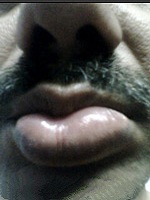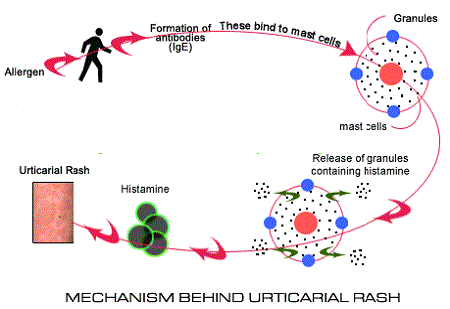- Our Location
- #604 1087 2nd Ave NW CALGARY ALBERTA,
POSTAL CODE T2N 5B2 Canada
- working hours
- Mon - Fri : 9:00 Am - 5:00 Pm
- Our Location
- #604 1087 2ND AVE NW CALGARY ALBERTA,
POSTAL CODE T2N 5B2 CANADA
- working hours
- Mon - Fri : 9:00 Am - 5:00 Pm
What is Urticaria?
Urticaria also called nettle-rash or hives or wheals in a common language, simply means itching with rash. Medically, urticaria may be defined as skin eruption, which is allergic (or non-allergic) in origin and is characterized by profound itching, red circular or irregularly shaped eruptions on any part of the body.
Urticaria is an allergic or non-allergic immunological disease, shown on the skin. Characteristically the skin eruptions are erythematous, raised above the skin level, with intense itching and usually worsened by itching an with slight local warmth. It can be acute or chronic; largely having a tendency to recur frequently for many months or years.
.jpg)


These eruptions can remain on the body for variable period anywhere between few seconds to even hours. They have tendency to disappear and reappear. They tend to disappear without leaving behind any trace.
Location and duration:

Well, urticaria may appear on any part of the skin. Angioedema is a condition when deep tissues are affected. The typical lesions may last for one minute to half an hour. Some may last even longer. Some patients may get the eruptions once in a while and some may have many times during the day. It may be restricted to a couple of spots in some patients, while some may have wide spread rashes appearing for days or even months together.
Histopathological view:
Under the microscope, a typical urticarial rash may exhibit perivascular, cellular infiltrate consisting of lymphocytes and eosinophils, is indicative of it's allergic behavior. There are findings related to edema (swelling) and mucosal inflammation.
Urticaria: The Inner War:
The urticaria rash is a symptom of an allergic and immunological event taking place at the dermal level. The exact understanding is illusive to an extent. In brief, urticaria is a hypersensitive reaction due to the histamine release. The histamine release could be from the mast cells when antigens and antibodies (IgM or IgG) combine to activate the immunological reaction. The histamine release could IgE induced. There are certain drugs, pharmacological agents (e.g.: antibiotics, morphine, aspirin, etc.), food articles (proteins, milk products, etc.) Urticaria is a sign of antigen-antibody reaction. During this process of antibody-antigen reaction, histamine and/or acetylcholine is generated which has the property of causing vessel dilatation (vasodilation) swelling, itching, pain and rash.

Causes of Urticaria (Hives)

Like many other disease conditions, we know what happens in urticaria more that what exactlycauses urticaria (hives). In almost half the cases we know what causes or induces urticaria; and half the time, the patients or we have no clue as to its exact cause.
Many people including some doctors believe that urticaria is allergic in nature. Actually, tt must be noted that Urticaria is not always allergic in nature. There are allergic and non-allergic causes for chronic urticaria. The non-allergic causes include auto-immunity related, hormonally triggered, stress triggered, exercise, drugs, temperature based and other factors.
We shall try to examine some of the most common exciting factors known to induce urticaria (hives), which may be grouped as:
Allergens: A large number of allergens have been identified as causative agents for some cases of urticaria. It may be noted that urticaria is an individual hypersensitivity and the following factors may not cause urticaria in all urticaria-prone individuals.
Food allergens: Milk, cheese, egg, protein products, wheat, cereals, nuts, certain daals as used in India, peas, orange, fish, chicken, etc. Synthetic and natural food additives and artificially-flavored food articles.
Urticaria and alcohol:
True anaphylactic reactions to alcohol (ethanol) are rare and most reactions to ingested alcoholic beverages are secondary to other chemicals in the beverage such as metabisulfite, papain, dyes or yeasts. However, there are reports of true allergic reactions in which the offending agent was shown to be the ethanol itself. Generally the symptoms of anaphylaxis occur in such patients following the ingestion of beer and/or wine. Urticaria rashes have been reported with ethanol ingestion; and hives on contact with ethanol have also been reported for some patients of urticaria.
Environmental factors:
Exposure to pollen, house-dust, buffalo dander, fungi, change in temperature, etc. are known exciting factors. Extreme cold, heat, pressure may also induce urticaria.
Drugs:
The major cause for urticaria are man-made drugs such as antibiotics (Penicillin), NSAIDs, anti-inflammatory drugs (aspirin, indomethacin), vaccinations, foreign sera, hormonal preparations, contraceptive pills, etc. Animals treated with penicillin excrete a small amount of it in the milk sufficient to cause urticaria in sensitive individuals.
Cholinergic factors:
Urticaria often gets triggered or aggravated by exercise, pressure on some part of the body as well as change in temperature of body after sweating. Such changes affect nerve ending of skin which lead to development of urticaria rash. In this variety of urticaria one experiences itching, burning and local heat on skin.
Urticaria and cocaine:
There have been reports of morphine-induced hives in some people. Bronchospasm may occur in some patients who smoke cocaine or in those who inject heroin. This may occur more often in patients who have a previous history of asthma. Hypersensitivity pneumonitis to cocaine has also been described and is associated with elevated levels of IgE.
Infections and infestations:
Insect bites, Fungal, protozoal, frequent bacterial infections (Urinary tract), viral infections (Hepatitis), helminthiasis (worm infestations such as round worms, tapeworms), etc. are factors known to cause urticaria. Domestic contact with the pet animals should be examined as cause for urticaria.
Synthetic products:
Use of personal products such as deodorant, perfume, and talcum powder, cosmetic products, animal derivatives, and similar synthetic substances may induce this disorder.
Emotional factors:
Especially in chronic, recurring cases of urticaria the role of emotional factors must be examined. Emotional stresses may directly or indirectly make on susceptible to develop a tendency to urticaria. The psychological factors may work as exciting, aggravating or maintaining cause. Especially, if you are under prolonged stress, anxiety, sadness or insecurity, such intense emotions could alter your immunological state and in turn lead to hypersensitivity.
Autoimmune causes:
Chronic urticaria is now understood to have autoimmune link. Presence of auto antibodies against Immunoglobulin E (IgE), CD23 (FcεRII or Fc epsilon RII) which releases histamine, hence leading to chronic urticaria.
Systemic and general disease:
Urticaria in some cases may present as a sign of other systemic or general internal disease such as hormonal disorders (hyperthyroidism), SLE, polycythaemia, reticuloses, etc. In certain variety of malignancies (cancer) urticaria may present as a precursor.
ORDER TREATMENT ONLINE
Our Homeopathy treatment is now just a few clicks away.
(Treatment for additional diseases charged at 50%)

 Find
out the chances
Find
out the chances
of cure (Free)

